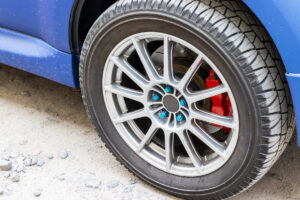Is your Subaru All-Wheel Drive (AWD) system acting up? It’s essential to recognize the signs of trouble and know how to troubleshoot them.
In this article, we’ll simplify the process by discussing common symptoms of a failing Subaru AWD system and straightforward troubleshooting steps.
6 Symptoms of a Failing Subaru AWD System
1. Unusual Noises
One of the early warning signs that your Subaru’s All-Wheel Drive (AWD) system may be experiencing issues is unusual noises.
These sounds can range from subtle to pronounced, but they all share one common characteristic: they shouldn’t be ignored.
Here are some noises you should listen for:
- Clunking: Heard during acceleration, deceleration, or while turning, this noise may mean worn-out components like CV joints or loose drivetrain connections.
- Whining/Whirring: High-pitched noises can signal problems with the differential or bearings, affecting stability and performance.
- Grinding/Growling: Occurring at low speeds or sharp turns, these sounds may indicate gear or transfer case issues.
- Clicking: Heard when turning, it can point to damaged CV joints, impacting power transfer.
2. Steering Difficulty
Steering difficulty can be a notable indicator of potential issues with your drivetrain.
While the steering system itself is distinct from the AWD system, they are interconnected, and problems in one can affect the other.
If you find it increasingly challenging to turn the steering wheel, especially during sharp turns or at low speeds, it may be linked to AWD system problems.
These issues can impact the distribution of power to the wheels, resulting in stiff or hard steering.
3. Vibration or Shaking
Experiencing vibration or shaking sensations while driving your Subaru can be a clear indicator of underlying issues with the AWD system.
AWD systems are designed to maintain smooth and stable power distribution to all four wheels, enhancing traction and stability in various driving conditions.
However, when you encounter vibrations or shaking, it’s a sign that this equilibrium has been disrupted.
These vibrations may become more pronounced during acceleration, affecting not only your driving comfort but also the overall performance of your vehicle.
Similarly, shaking, especially during turns or low-speed maneuvers, can signify problems related to your AWD system.
4. Reduced Traction
Reduced traction is a notable concern when it comes to AWD (All-Wheel Drive) system issues in your Subaru.
AWD systems are specifically designed to enhance traction by distributing power to all four wheels, providing better control and stability in diverse road conditions. When you experience reduced traction, it can signal that your Subaru’s AWD system may not be functioning optimally.
Common Signs of Reduced Traction:
- Difficulty accelerating on inclines
- Tire spin
When traction is compromised due to AWD system problems, it can lead to difficulties in handling, decreased stability, and increased safety risks.
5. Warning Lights
The primary warning light to watch for is the “AWD” warning or similar symbols.
When illuminated, it signifies a detected AWD problem requiring immediate attention.
The ABS (Anti-lock Braking System) light, although not directly linked to the AWD system, can also turn on due to interconnected systems.
Ignoring these warning lights can result in more significant damage and safety concerns. If you see either of these lights on your dashboard, it’s crucial to address the issue promptly to ensure safe driving.
6. Uneven Tire Wear
Uneven tire wear is a concern linked to potential AWD (All-Wheel Drive) system issues in your Subaru.
AWD systems are designed for even power distribution to all four wheels, promoting balanced tire wear.
When you notice uneven tire wear, it can suggest AWD system imbalances. This issue often appears as differences in tread depth, camber wear, or feathering among the tires.
Maintaining even tire wear is crucial for tire longevity, vehicle stability, and safety. AWD systems play a key role in achieving this balance.
Uneven tire wear can lead to reduced tire lifespan, decreased traction, and handling problems.
To learn more about Subarus AWD System, read this article next!

How to Troubleshoot a Failing Subaru AWD System
1. Check Fluid Levels
Maintaining proper fluid levels is vital for the health and performance of your Subaru’s AWD system.
Three primary fluids to monitor are transmission fluid, differential fluid, and brake fluid.
Transmission Fluid
Transmission fluid plays a crucial role in ensuring smooth power transfer between the engine and the wheels.
To check your transmission fluid:
- Park your vehicle on a level surface and let the engine warm up.
- Locate the transmission fluid dipstick, which is usually marked in red or yellow for easy identification.
- Pull out the dipstick, wipe it clean, reinsert it fully, and then pull it out again.
- Examine the fluid level, which should fall within the designated range on the dipstick. Additionally, observe the fluid’s color and odor. Clean, reddish fluid indicates good condition, while dirty or foul-smelling fluid may necessitate a change.
Differential Fluid
The differential is responsible for distributing torque between the wheels. Ensuring the proper level of differential fluid is essential for balanced traction.
Here’s how to check it:
- Locate the differential fill plug, often situated on the rear axle or differential housing.
- Remove the fill plug and inspect the fluid level, which should be near the fill hole’s opening.
Brake Fluid
Brake fluid is essential for the ABS (Anti-lock Braking System) and contributes to overall vehicle stability and control. Issues with ABS are notorious for causing the AWD to act up in Subarus.
To verify its level:
- Pop the hood and locate the brake fluid reservoir.
- Examine the fluid level, ensuring it falls between the minimum and maximum markings on the reservoir.
Regularly checking and maintaining these fluid levels is essential for your Subaru’s AWD system’s proper operation.
Low or contaminated fluids can lead to imbalances, reduced traction, and potential safety risks.
If you discover low fluid levels or signs of leakage during the inspection, it’s crucial to address these issues promptly to keep your AWD system in top condition
2. Inspect Tires
An issue with your tires can have similar symptoms to a failing AWD system. Here’s how to troubleshoot your tires:
- Tire Pressure: Verify that your tires are at the recommended pressure levels to maintain AWD system efficiency and proper handling. Any irregularities in the tire pressure can mess with your AWD.
- Tread Wear: Inspect tread depth for even wear. Uneven wear may necessitate tire rotation.
- Balancing and Alignment: Look for signs of imbalance or misalignment, which can lead to vibrations and reduced handling.
- Tire Condition: Check for damage like cuts, punctures, or bulges, as damaged tires can compromise safety and AWD performance.
- Tire Quality: Ensure all tires are the same make, model, and size to maintain consistent AWD operation.
3. Scan for Error Codes
Modern Subarus are equipped with onboard diagnostics that can provide valuable insights into potential issues affecting your AWD system. Here’s what to do:
- Get an OBD-II scanner compatible with your Subaru.
- Locate the OBD-II port beneath the dashboard near the driver’s seat.
- Plug in the scanner.
- Turn the ignition to “On” without starting the engine.
- Use the scanner to read error codes, focusing on AWD-related codes like C0407, C0408, or C04091.
- Record the codes and consult your vehicle’s manual or online resources for interpretations.
4. Visual Inspection
When it comes to a visual inspection, here are some key components to check for damage, cracks, and leaks:
- CV Joints and Boots
- Differential Housing
- Wheel Bearings
- Transfer Case
- Driveshafts
- Suspension Components

When to See a Mechanic
See a mechanic if your Subaru displays warning lights like “Check Engine” or “AWD.” Unusual noises, steering problems, or brake issues demand attention.
Fluid leaks, especially in Subaru’s AWD system, must be addressed promptly. Engine performance problems, electrical issues, or irregular tire wear should prompt a visit to a Subaru-experienced mechanic. If you are in Little Rock, AR, schedule your service today at SL Autoworks!



